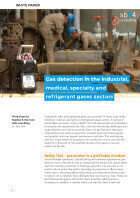Gas Detection
Gas detection in the industrial, medical, specialty and refrigerant gases sectors
Aug 03 2020
Author: Stephen B. Harrison on behalf of sbh4 GmbH
Flammable, toxic and asphyxiant gases are processed 24 hours a day in the industrial, medical, speciality and refrigerants gases sectors. A myriad of preventative processes, such as HAZOP and risk assessments are undertaken to minimise the operational risk. Also, real-time monitoring techniques such
as gas detection are used to sound the alarm if a gas leak does take place. Fixed systems can protect equipment, wearable units can protect people and portable units can support maintenance activities. The most appropriate mix of gas detection equipment on a production or end-user site will largely be influenced by the potential hazards of the gases in use and present on the site.
Safety first – prevention is a profitable mindset
Across tonnage operations, cylinder filling and customer applications, gas detection has a vital role to play in protecting both people and capital assets. And with business continuity in mind, gas detection can also play an important role in protecting profits. Investing in prevention is often money wisely spent. Identifying potential problems and proactively taking action to reduce risk is infinitely more desirable than reacting to a crisis. These are the fundamental arguments behind many proactive safety practices. Investment in safety is a mindset which can take the form of low-risk process selection, reliable equipment specification and encouraging behavioural or cultural best practices. The installation of gas detection instrumentation to raise the alarm before a situation escalates to a dangerous level can also play an essential role in a mix of mitigation and prevention strategies. The links between gas detection equipment and automated responses or human behaviour are also essential to work through. Often, an escalating approach to alarms is taken. For example, a low-level gas detection reading may result in a cautionary audible and visible alarm and automatically trigger an increase in ventilation. This could
give operators the chance to investigate and rectify the situation. At a higher gas leak detection level, an automated shut-down of the process may be the appropriate response.
Digital Edition
AET 28.2 April/May 2024
May 2024
Business News - Teledyne Marine expands with the acquisition of Valeport - Signal partners with gas analysis experts in Korea Air Monitoring - Continuous Fine Particulate Emission Monitor...
View all digital editions
Events
Jul 30 2024 Jakarta, Indonesia
China Energy Summit & Exhibition
Jul 31 2024 Beijing, China
2024 Beijing International Coal & Mining Exhibition
Aug 07 2024 Beijing, China
IWA World Water Congress & Exhibition
Aug 11 2024 Toronto, Canada
Aug 25 2024 Stockholm, Sweden and online






.jpg)








